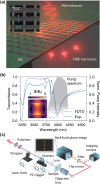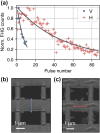Nonlinear mid-infrared meta-membranes
- PMID: 39634836
- PMCID: PMC11501238
- DOI: 10.1515/nanoph-2024-0203
Nonlinear mid-infrared meta-membranes
Abstract
Nanophotonic structures have shown promising routes to controlling and enhancing nonlinear optical processes at the nanoscale. However, most nonlinear nanostructures require a handling substrate, reducing their application scope. Due to the underwhelming heat dissipation, it has been a challenge to evaluate the nonlinear optical properties of free-standing nanostructures. Here, we overcome this challenge by performing shot-controlled fifth harmonic generation (FHG) measurements on a SiC meta-membrane - a free-standing transmission metasurface with pronounced optical resonances in the mid-infrared (λ res ≈ 4,000 nm). Back focal plane imaging of the FHG diffraction orders and rigorous finite-difference time-domain simulations reveal at least two orders of magnitude enhancement of the FHG from the meta-membrane, compared to the unstructured SiC film of the same thickness. Single-shot measurements of the meta-membrane with varying resonance positions reveal an unusual spectral behavior that we explain with Kerr-driven intensity-dependent resonance dynamics. This work paves the way for novel substrate-less nanophotonic architectures.
Keywords: metasurfaces; mid-infrared; nonlinear optics; silicon carbide.
© 2024 the author(s), published by De Gruyter, Berlin/Boston.
Conflict of interest statement
Conflict of interest: Authors state no conflicts of interest.
Figures




References
-
- Smirnova D., Kivshar Y. S. Multipolar nonlinear nanophotonics. Optica . 2016;3(11):1241. doi: 10.1364/optica.3.001241. - DOI
-
- Shen Y., et al. Deep learning with coherent nanophotonic circuits. Nat. Photonics . 2017;11(7):441–446. doi: 10.1038/nphoton.2017.93. - DOI
-
- Huang C., Jha A., de Lima T. F., Tait A. N., Shastri B. J., Prucnal P. R. On-chip programmable nonlinear optical signal processor and its applications. IEEE J. Sel. Top. Quantum Electron. . 2021;27(2):6100211.
-
- Liu X., Osgood R. M., Vlasov Y. A., Green W. M. J. Mid-infrared optical parametric amplifier using silicon nanophotonic waveguides. Nat. Photonics . 2010;4(8):557–560. doi: 10.1038/nphoton.2010.119. - DOI
LinkOut - more resources
Full Text Sources
